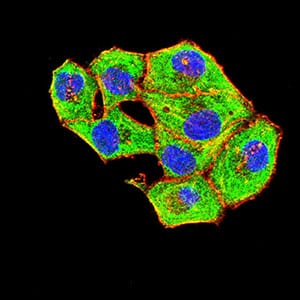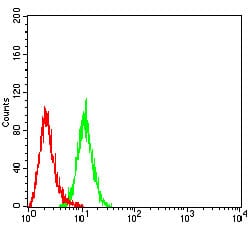


| WB | 咨询技术 | Human,Mouse,Rat |
| IF | 咨询技术 | Human,Mouse,Rat |
| IHC | 咨询技术 | Human,Mouse,Rat |
| ICC | 1/100 - 1/500 | Human,Mouse,Rat |
| FCM | 1/200 - 1/400 | Human,Mouse,Rat |
| Elisa | 1/10000 | Human,Mouse,Rat |
| Aliases | HAP; BAG-1; RAP46 |
| Entrez GeneID | 573 |
| clone | 1E4B5 |
| WB Predicted band size | 38.8kDa |
| Host/Isotype | Mouse IgG1 |
| Antibody Type | Primary antibody |
| Storage | Store at 4°C short term. Aliquot and store at -20°C long term. Avoid freeze/thaw cycles. |
| Species Reactivity | Human |
| Immunogen | Purified recombinant fragment of human BAG1 (AA: 219-346) expressed in E. Coli. |
| Formulation | Purified antibody in PBS with 0.05% sodium azide |
+ +
以下是关于BAG1抗体的3篇代表性文献(信息基于公开研究整理,具体内容需参考原文):
---
1. **文献名称**:*BAG-1: A multifunctional regulator of cell growth and survival*
**作者**:Takayama S, et al.
**摘要**:该研究阐明了BAG1蛋白通过与热休克蛋白(Hsp70)相互作用调控细胞应激反应和抗凋亡功能的机制,并开发了特异性BAG1抗体用于蛋白定位及表达水平检测,为癌症治疗靶点研究提供工具支持。
---
2. **文献名称**:*BAG1 as a prognostic biomarker in breast cancer: An immunohistochemical study*
**作者**:Kudoh K, et al.
**摘要**:通过免疫组化技术结合BAG1抗体,研究发现BAG1在乳腺癌组织中高表达与患者预后不良相关,提示其可作为乳腺癌分层的潜在生物标志物。
---
3. **文献名称**:*BAG1 modulates the chaperone activity of Hsp70 in neurodegenerative disease models*
**作者**:Lüders J, et al.
**摘要**:利用BAG1抗体在阿尔茨海默病模型中进行蛋白互作分析,揭示了BAG1通过调节Hsp70的分子伴侣活性影响tau蛋白聚集,为神经退行性疾病机制研究提供新视角。
---
如需获取全文或更多文献,建议通过PubMed或Web of Science数据库检索DOI信息。
The BAG1 (Bcl-2-associated athanogene 1) antibody is a tool used to detect the BAG1 protein, a key regulator of cellular stress responses and apoptosis. BAG1 interacts with heat shock proteins (Hsp70/Hsc70) via its conserved BAG domain, modulating protein folding, degradation, and client protein activity. It also binds to anti-apoptotic Bcl-2 family members, enhancing cell survival under stress. Alternative splicing generates multiple isoforms (e.g., p50. p46. p33), which localize to the cytoplasm, nucleus, or mitochondria, influencing diverse functions like proliferation, differentiation, and stress adaptation.
BAG1 is implicated in cancer progression, where its overexpression in malignancies like breast cancer and melanoma correlates with poor prognosis and therapy resistance. Conversely, reduced BAG1 levels are linked to neurodegenerative disorders, such as Alzheimer’s disease, suggesting a neuroprotective role.
BAG1 antibodies are essential in research and diagnostics, enabling detection via Western blotting, immunohistochemistry, and immunofluorescence. They help elucidate BAG1’s tissue-specific expression, subcellular distribution, and interaction networks. Commercial antibodies often target conserved regions (e.g., N-terminal or BAG domain) but require validation for isoform specificity. Dysregulation of BAG1 pathways underscores its therapeutic potential, making these antibodies valuable for studying molecular mechanisms in cancer, neurodegeneration, and cellular stress responses.
×